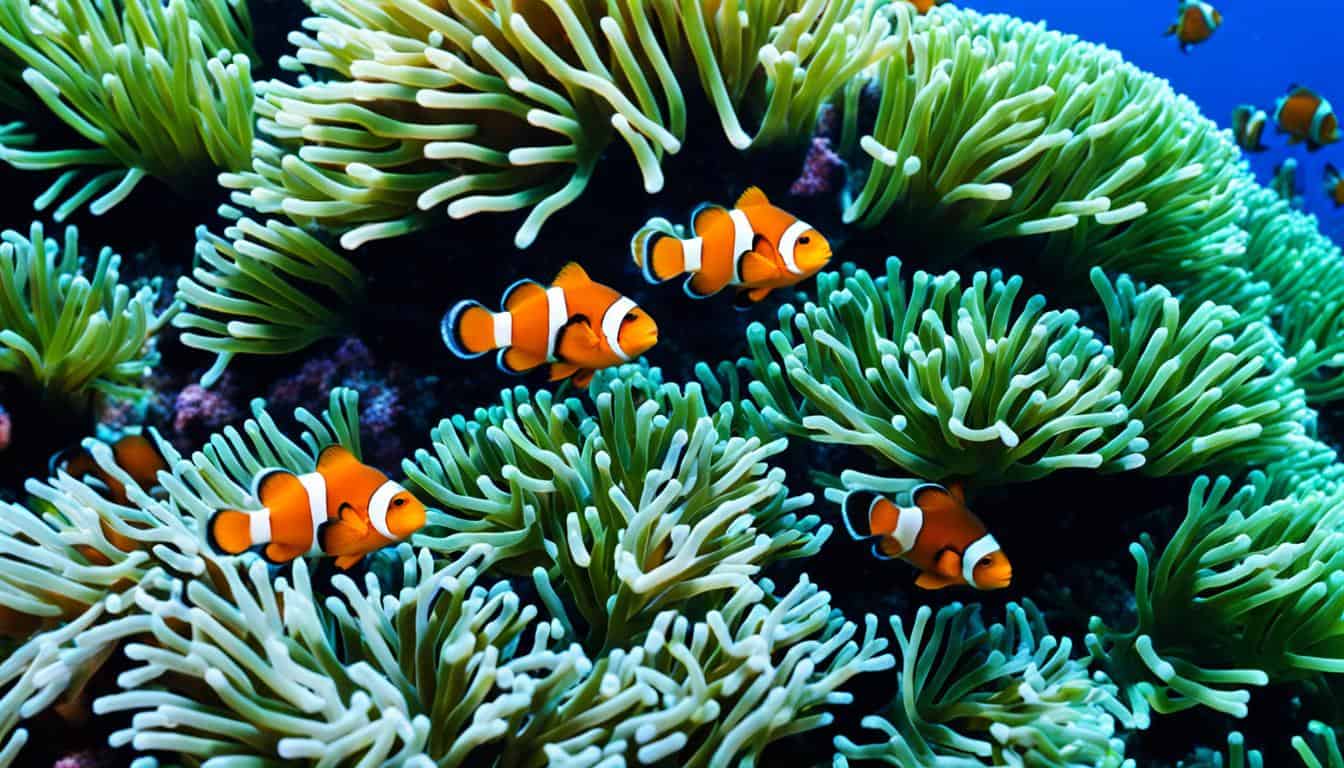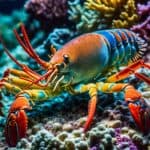Clownfish, like Amphiprion ocellaris and Amphiprion percula, have bright orange and white colors. This makes you wonder, why are they orange and white? These colors are key for their survival and communication.
They help the clownfish blend in with their sea anemone homes and warn off predators. By learning about their colors, we can see how they’ve adapted over time. This is crucial for their role in coral reef ecosystems.
This article will dive into the science of clownfish colors. We’ll look at their biology, genetics, and how they interact with their surroundings. Whether you love the ocean or just find it fascinating, you’ll see why these fish are so colorful.
The Unique Colors of Clownfish: An Introduction
Clownfish are fascinating marine creatures known for their bright colors. Their orange body and white stripes make them stand out. These colors are more than just pretty; they play a big role in their survival.
These fish live in warm, shallow reefs and have a special relationship with sea anemones. They live among the anemones for safety from predators. Their colors help them blend in, keeping them safe.
This camouflage is key to their survival and helps them find mates. It shows how important their looks are for their life and success.
Learning about the clownfish’s colors helps us understand their evolution. Their unique traits show how nature helps them survive. This makes clownfish a fascinating topic in marine biology.
Why are clownfish orange and white?
Clownfish are known for their bright orange and white colors. These colors are not just for show. They are vital for their survival and how they interact with other sea creatures.
The symbiotic relationship with sea anemones
The orange and white colors of clownfish help them blend in with their sea anemone homes. This special relationship helps both the fish and the anemone. Clownfish keep the anemones safe from predators, and in return, they get food and help with oxygen.
Adaptations in coloration for survival
Clownfish colors change based on where they live. For example, those living near more dangerous anemones might have fewer white stripes. This could be a way to warn off predators. It shows how clownfish have evolved to stay safe in their underwater world.
Clownfish Colors: The Basics
The vibrant colors of clownfish are a treat for both aquarists and ocean lovers. With about 30 different species, these fish show off a wide range of colors and patterns. Each type has its own unique coloration, fitting perfectly with its home anemone.
The spectrum of colors in clownfish species
The most well-known clownfish color mix is orange with white stripes. But there’s more to see. Some species have bright yellow or deep black colors, with different stripe patterns. These colors help them stand out and survive in the wild.
Here’s a table showing some common clownfish species and their colors:
| Clownfish Species | Common Colors | Distinctive Patterns |
|---|---|---|
| Amphiprion ocellaris | Orange and white | Three white stripes |
| Amphiprion percula | Bright orange | Thinner, defined stripes |
| Amphiprion melanopus | Dark orange to reddish | Three or four stripes |
| Amphiprion clarkii | Yellow with black | Two to four black stripes |
Factors affecting clownfish skin color and patterns
Many things can change a clownfish’s color, like its genes, where it lives, and its anemone home. For example, those living in more toxic anemones often have less bright colors and patterns. This shows how these fish change their look to fit their environment.
Clownfish Pigmentation: The Science Behind It
The bright colors of clownfish come from special cells that make pigments. These cells help them look the way they do and are key to their survival. Learning about clownfish colors shows us how they live in the ocean.
The role of pigment cells in coloration
Pigment cells called iridophores are vital for clownfish colors. They reflect light, making the fish look orange and white. As clownfish grow, these cells become more important. They help create the white bars and colors that make each fish unique in the sea.
How environmental factors influence pigmentation
Environmental factors affect clownfish colors, not just their genes. Things like water quality, light, and the anemones they live in can change their colors. For example, those in bright areas might be more colorful than those in the shade.
This shows how clownfish change their colors to fit their surroundings. It helps them survive in different places in the ocean.

Clownfish Genetics and Coloration
Clownfish color comes from a mix of genetic factors. By studying clownfish genetics, we learn how genes affect pigment production. These genes shape the bright colors we see in different clownfish species.
Scientists look at clownfish genomes to link genes with color changes. This shows how genetics is key to their eye-catching colors.
The genetic basis for clownfish color patterns
Clownfish color is rooted in their genes. Certain genes control the production of pigments for their unique looks. These traits help them survive in their homes.
Changes in these genes can alter clownfish colors. This shows how genetics deeply affects their appearance.
Domestication effects on clownfish coloration
Domesticated clownfish have changed in color due to selective breeding. Breeders have created new colors not seen in the wild. This shows how humans can change fish colors.
These changes give us clues about how clownfish adapt in new environments.
Clownfish Biology: Understanding Their Metamorphosis
Metamorphosis is key in clownfish biology, changing their coloration deeply. As they grow from larvae to adults, they change a lot physically. This includes the growth of their famous white bars. This change often happens when they live in sea anemones, where their colors help them survive.
The metamorphosis process and its impact on coloration
During metamorphosis, clownfish go through big changes. The white bars start to show as they adjust to their ocean home. This shows how important their colors are for living in their environment. It also helps them avoid predators.
The growth of the bars depends on things like water temperature and food availability. These can change a lot in the ocean.
The role of thyroid hormones in color change
Thyroid hormones help control how fast clownfish change color. When these hormones go up, the fish change faster, including getting their stripes quicker. This shows how important these hormones are in their development.
Knowing about this helps us understand how clownfish get their colors.
Clownfish Natural Coloration: Evolution and Adaptation
The natural color of clownfish is a great example of how evolution shapes survival traits. Their bright orange and white colors are key to their survival. They match their colors to the sea anemones they live in, helping them hide from predators.
How coloration relates to habitat and predator avoidance
Color helps clownfish blend into their home. This camouflage is crucial for avoiding predators. Living among sea anemone tentacles, their colors help them hide and support a mutual relationship with the anemones.
Coloration as a response to environmental pressures
Clownfish colors can change due to environmental changes. Habitat destruction and new predators stress them out. Those with better camouflage patterns are more likely to survive and reproduce.
This struggle for survival drives the evolution of their colors. It shows how ecology and evolution work together in their ocean homes.
FAQ
Why are clownfish orange and white?
Clownfish are orange and white for important reasons. These colors help them blend in and warn off predators. They live with sea anemones and their colors help them survive.
What are the different colors of clownfish?
Clownfish come in many colors and patterns. Orange and white are the most common. But, different species have their own unique colors suited to their homes and needs.
How do environmental factors influence clownfish pigmentation?
Things like water quality and light affect clownfish colors. They also change color based on the sea anemone they live with. This helps them hide from predators and survive.
What role do genetics play in clownfish coloration?
Genetics is key to clownfish colors. Certain genes control the pigments and patterns. This shows a strong link between genes and their colors.
How do clownfish develop their characteristic stripes?
Clownfish get their white stripes as they grow from larvae to adults. This change is affected by their environment and the sea anemones they live with. It helps them blend in better.
What is the significance of the symbiotic relationship between clownfish and sea anemones?
Clownfish live with sea anemones for safety from predators. They help the anemones by bringing food and oxygen. This helps both species survive.
How does domestication affect clownfish coloration?
Domesticated clownfish look different from wild ones because of selective breeding. This has created new colors and patterns that don’t occur naturally. It shows how humans can change animal colors.
What influences the adaptive nature of clownfish coloration?
Things like habitat loss and predators affect clownfish colors. Through natural selection, those with better colors for hiding or signaling are more likely to live and have babies.







